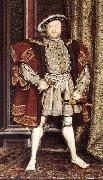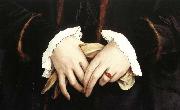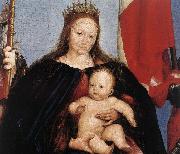HOLBEIN, Hans the YoungerGerman painter (b. 1497, Augsburg, d. 1543, London). | |||
 |
|||
|
|
|
||||||||||
|
|
||||||||||
|
Henry VIII after ID de tableau:: 63707 Voir la galerie dans Suède |
Henry VIII after 1537 Oil on canvas, 233,7 x 134,6 Walker Art Gallery, Liverpool The top job of Holbein, the court painter, was quite certainly to paint the king's portrait. In the 1530s, Henry VIII had enlarged his London residence Whitehall Palace, and needed a grand picture for it. It was to feature not only him and his wife Jane Seymour, but also his parents, the first Tudor monarchs, and was also intended to proclaim the fame of the ruling house in word and image. Since the composition probably adorned one wall of the Privy Chamber, a private chamber accessible only to more intimate members of court, the picture was not aimed at a broad public but a select group at court. No contract for the mural survives, but Henry VIII must have commissioned it in the short time during which he was married to Jane Seymour, in other words between May 30, 1536, and October 12, 1537. Both Catharine of Aragon and Anne Boleyn were already dead; in showing Jane together with Elizabeth of York and the Tudor monarchs in the picture, Henry's new connection was presented as the only legitimate one and the children of the marriage as the only rightful heirs. Possibly the picture was commissioned shortly after the wedding: in the surviving section of the cartoon a cartouche is included in the frieze, displaying the initials of Henry and Jane linked in a love knot. According to the copy by the painter Remigius van Leemput (1607-1675) in 1667, the cartouche on the mural as painted bore the date 1537. The picture shows a copy of the figure of Henry VIII from the left side of the mural which was destroyed in the Whitehall fire in 1698. Henry VIII stands in the foreground like a colossus with legs apart and knees straight. His broad shoulders, emphasized by his heavy clothing, exaggerate the already unusual physical presence of this large man, whose sex is additionally stressed by a prominent girdle and codpiece. The king thus appears as the epitome of vigour and potency. This stance, with legs apart and knees locked straight, is very uncommon for the portrait of a king. The reason may be that at the time spread legs were considered improper, as the Frankfurt scholar Jodocus Willich ( 1501-15 52) explains in a treatise on gestures first published in Basle in 1540. However, in visual art the stance was also associated with triumphant heroes; St. George, for example, can stand in a comparable pose after overcoming the dragon.Artist:HOLBEIN, Hans the Younger Title: Henry VIII Painted in 1501-1550 , German - - painting : portrait 1537_Oil_on_canvas,_233,7_x_134,6_Walker_Art_Gallery,_Liverpool_The_top_job_of_Holbein,_the_court_painter,_was_quite_certainly_to_paint_the_king's_portrait._In_the_1530s,_Henry_VIII_had_enlarged_his_London_residence_Whitehall_Palace,_and_needed_a_grand_picture_for_it._It_was_to_feature_not_only_him_and_his_wife_Jane_Seymour,_but_also_his_parents,_the_first_Tudor_monarchs,_and_was_also_intended_to_proclaim_the_fame_of_the_ruling_house_in_word_and_image._Since_the_composition_probably_adorned_one_wall_of_the_Privy_Chamber,_a_private_chamber_accessible_only_to_more_intimate_members_of_court,_the_picture_was_not_aimed_at_a_broad_public_but_a_select_group_at_court._No_contract_for_the_mural_survives,_but_Henry_VIII_must_have_commissioned_it_in_the_short_time_during_which_he_was_married_to_Jane_Seymour,_in_other_words_between_May_30,_1536,_and_October_12,_1537._Both_Catharine_of_Aragon_and_Anne_Boleyn_were_already_dead;_in_showing_Jane_together_with_Elizabeth_of_York_and_the_Tudor_monarchs_in_the_picture,_Henry's_new_connection_was_presented_as_the_only_legitimate_one_and_the_children_of_the_marriage_as_the_only_rightful_heirs._Possibly_the_picture_was_commissioned_shortly_after_the_wedding:_in_the_surviving_section_of_the_cartoon_a_cartouche_is_included_in_the_frieze,_displaying_the_initials_of_Henry_and_Jane_linked_in_a_love_knot._According_to_the_copy_by_the_painter_Remigius_van_Leemput_(1607-1675)_in_1667,_the_cartouche_on_the_mural_as_painted_bore_the_date_1537._The_picture_shows_a_copy_of_the_figure_of_Henry_VIII_from_the_left_side_of_the_mural_which_was_destroyed_in_the_Whitehall_fire_in_1698._Henry_VIII_stands_in_the_foreground_like_a_colossus_with_legs_apart_and_knees_straight._His_broad_shoulders,_emphasized_by_his_heavy_clothing,_exaggerate_the_already_unusual_physical_presence_of_this_large_man,_whose_sex_is_additionally_stressed_by_a_prominent_girdle_and_codpiece._The_king_thus_appears_as_the_epitome_of_vigour_and_potency._This_stance,_with_legs_apart_and_knees_locked_straight,_is_very_uncommon_for_the_portrait_of_a_king._The_reason_may_be_that_at_the_time_spread_legs_were_considered_improper,_as_the_Frankfurt_scholar_Jodocus_Willich_(_1501-15_52)_explains_in_a_treatise_on_gestures_first_published_in_Basle_in_1540._However,_in_visual_art_the_stance_was_also_associated_with_triumphant_heroes;_St._George,_for_example,_can_stand_in_a_comparable_pose_after_overcoming_the_dragon.Artist:HOLBEIN,_Hans_the_Younger_Title:_Henry_VIII___Painted_in__1501-1550___,__German__-_-_painting__:_portrait |
|||||||||
|
|
||||||||||
|
Christina of Denmark ID de tableau:: 63708 Voir la galerie dans Suède |
Christina of Denmark 1538 Oil on oak National Gallery, London Christina's black gown, which she wore as a widow, contrasts strikingly with her flawless ivory skin. The viewer's gaze is also attracted to the well-shaped, delicate hands holding a glove, leaving an impression of perfect charm and elegance.Artist:HOLBEIN, Hans the Younger Title: Christina of Denmark, Ducchess of Milan (detail) Painted in 1501-1550 , German - - painting : portrait 1538_Oil_on_oak_National_Gallery,_London_Christina's_black_gown,_which_she_wore_as_a_widow,_contrasts_strikingly_with_her_flawless_ivory_skin._The_viewer's_gaze_is_also_attracted_to_the_well-shaped,_delicate_hands_holding_a_glove,_leaving_an_impression_of_perfect_charm_and_elegance.Artist:HOLBEIN,_Hans_the_Younger_Title:_Christina_of_Denmark,_Ducchess_of_Milan_(detail)___Painted_in__1501-1550___,__German__-_-_painting__:_portrait |
|||||||||
|
|
||||||||||
|
The Solothurn Madonna ID de tableau:: 63710 Voir la galerie dans Suède |
The Solothurn Madonna 1522 Limewood Museum der Stadt Solothurn, Solothurn The original painting by Holbein was revealed only after restoration by Thomas Brachert in 1971; it had been completely overpainted in the Pre-Raphaelite style by the 19th century restorer Andreas Eigner. Eigner's aim was twofold: not only to "beautify" the picture, but also to cover up the many wormholes that had appeared. Restoration showed up the extensive craquelure that had been covered over and which regrettably spoils the fine modeling of the flesh tones in particular.Artist:HOLBEIN, Hans the Younger Title: The Solothurn Madonna (detail) Painted in 1501-1550 , German - - painting : religious 1522_Limewood_Museum_der_Stadt_Solothurn,_Solothurn_The_original_painting_by_Holbein_was_revealed_only_after_restoration_by_Thomas_Brachert_in_1971;_it_had_been_completely_overpainted_in_the_Pre-Raphaelite_style_by_the_19th_century_restorer_Andreas_Eigner._Eigner's_aim_was_twofold:_not_only_to_"beautify"_the_picture,_but_also_to_cover_up_the_many_wormholes_that_had_appeared._Restoration_showed_up_the_extensive_craquelure_that_had_been_covered_over_and_which_regrettably_spoils_the_fine_modeling_of_the_flesh_tones_in_particular.Artist:HOLBEIN,_Hans_the_Younger_Title:_The_Solothurn_Madonna_(detail)___Painted_in__1501-1550___,__German__-_-_painting__:_religious |
|||||||||
|
|
||||||||||
|
St Ursula ID de tableau:: 63711 Voir la galerie dans Suède |
St Ursula 1523 Tempera on wood, 96,4 x 41,9 cm Staatliche Kunsthalle, Karlsruhe The panel probably belonged to a dismembered altarpiece. It was executed in the workshop of Holbein.Artist:HOLBEIN, Hans the Younger Title: St Ursula Painted in 1501-1550 , German - - painting : religious 1523_Tempera_on_wood,_96,4_x_41,9_cm_Staatliche_Kunsthalle,_Karlsruhe_The_panel_probably_belonged_to_a_dismembered_altarpiece._It_was_executed_in_the_workshop_of_Holbein.Artist:HOLBEIN,_Hans_the_Younger_Title:_St_Ursula___Painted_in__1501-1550___,__German__-_-_painting__:_religious |
|||||||||
|
|
||||||||||
|
Darmstadt Madonna ID de tableau:: 63712 Voir la galerie dans Suède |
Darmstadt Madonna 1526 and after 1528 Oil on limewood Schlossmuseum, Darmstadt The presentation of the Madonna and Child is a triumph of illusionism that ranks with the achievements of Van Eyck in Flanders a century before. The play of light over the fluting of the architectural shell behind the two figures carves out the space into which the delicately shadowed crown, hair and face of the Madonna are set. There is no Raphaelesque regularity in the Madonna's features - as with most northern Madonnas, a specific model was used, a friend of Holbein's, one Magdalena Offenburg who also posed for the Lais and whose lifestyle, ironically, was not considered blameless. However, the compelling physical presence and credibility of the figures is the result of artistic means alone; the twisting of the child's body emphasizes the weight the Madonna's arms must carry, and Christ's projecting feet and the foreshortening of his own and his mother's arms stress the space his torso occupies. The combination of warm green and gold also brings the Madonna forward against the neutral .tone of the stonework.Artist:HOLBEIN, Hans the Younger Title: Darmstadt Madonna (detail) Painted in 1501-1550 , German - - painting : religious 1526_and_after_1528_Oil_on_limewood_Schlossmuseum,_Darmstadt_The_presentation_of_the_Madonna_and_Child_is_a_triumph_of_illusionism_that_ranks_with_the_achievements_of_Van_Eyck_in_Flanders_a_century_before._The_play_of_light_over_the_fluting_of_the_architectural_shell_behind_the_two_figures_carves_out_the_space_into_which_the_delicately_shadowed_crown,_hair_and_face_of_the_Madonna_are_set._There_is_no_Raphaelesque_regularity_in_the_Madonna's_features_-_as_with_most_northern_Madonnas,_a_specific_model_was_used,_a_friend_of_Holbein's,_one_Magdalena_Offenburg_who_also_posed_for_the_Lais_and_whose_lifestyle,_ironically,_was_not_considered_blameless._However,_the_compelling_physical_presence_and_credibility_of_the_figures_is_the_result_of_artistic_means_alone;_the_twisting_of_the_child's_body_emphasizes_the_weight_the_Madonna's_arms_must_carry,_and_Christ's_projecting_feet_and_the_foreshortening_of_his_own_and_his_mother's_arms_stress_the_space_his_torso_occupies._The_combination_of_warm_green_and_gold_also_brings_the_Madonna_forward_against_the_neutral_.tone_of_the_stonework.Artist:HOLBEIN,_Hans_the_Younger_Title:_Darmstadt_Madonna_(detail)___Painted_in__1501-1550___,__German__-_-_painting__:_religious |
|||||||||
|
|
||||||||||
| Artiste précédent Artiste prochain | ||||||||||
|
|
||||||||||
| HOLBEIN, Hans the Younger | ||||||||||
| German painter (b. 1497, Augsburg, d. 1543, London). | ||||||||||
|
|
||||||||||
IntoFineArt Co,.Ltd.













